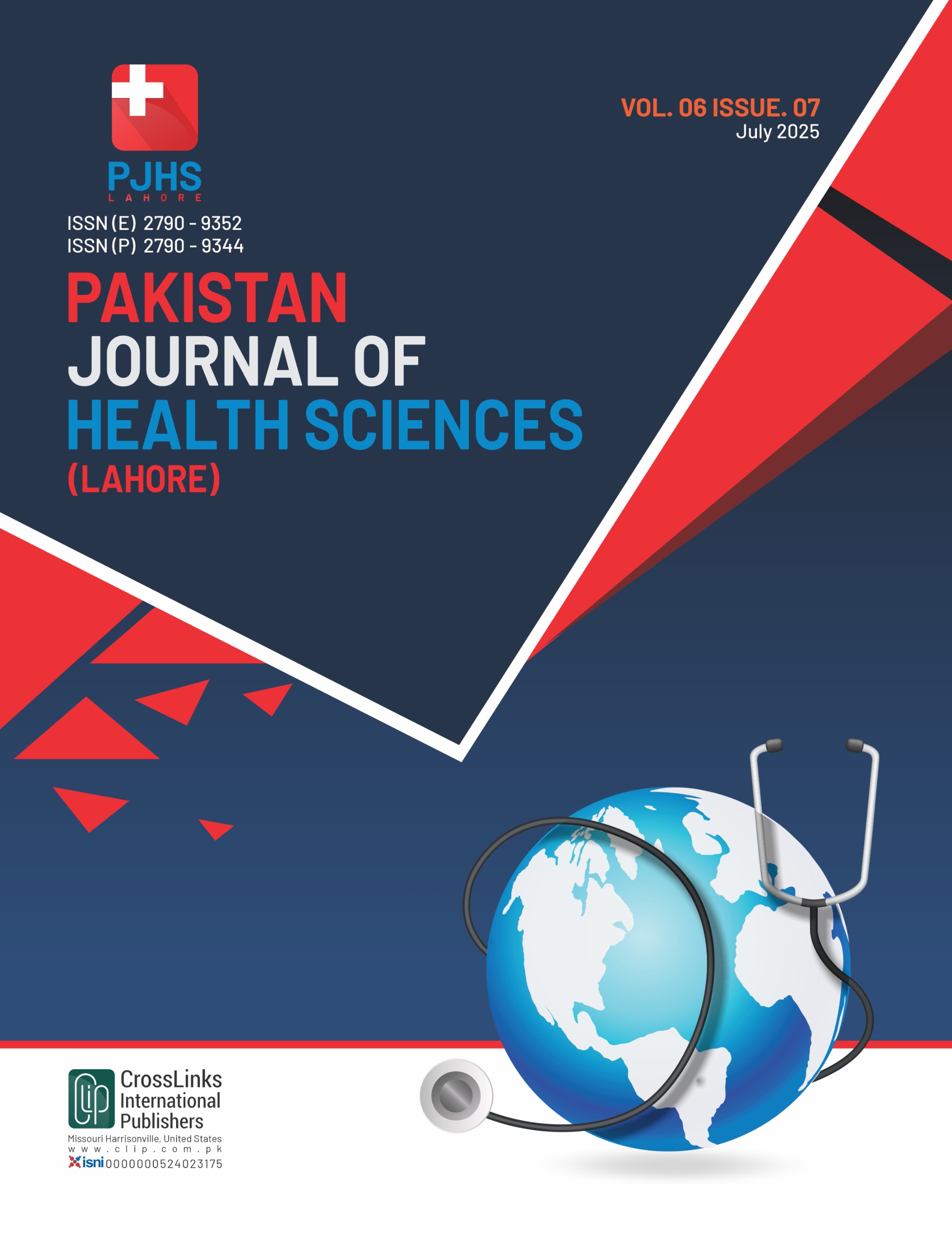Clinical Profile and Predictors of Posterior Reversible Encephalopathy Syndrome at Tertiary Care Hospital, Peshawar
Clinical Profile and Predictors of Posterior Reversible Encephalopathy Syndrome
DOI:
https://doi.org/10.54393/pjhs.v6i7.3240Keywords:
Posterior Reversible Encephalopathy Syndrome, Clinical Profile, Predictors, Hypertension, Preeclampsia, SeizuresAbstract
Posterior Reversible Encephalopathy Syndrome is an acute neurological condition characterized by reversible subcortical vasogenic edema, often presenting with seizures, headache, visual disturbances, and altered mental status. Objectives: To evaluate the clinical profile, risk factors, radiological findings, and outcomes of Posterior Reversible Encephalopathy Syndrome patients at a tertiary care hospital in Peshawar. Methods: This prospective cohort study was conducted at Northwest General Hospital and Research Center, Peshawar, from January 2023 to March 2025. Ninety patients diagnosed with Posterior Reversible Encephalopathy Syndrome through clinical presentation and Magnetic Resonance Imaging confirmation were enrolled using non-probability consecutive sampling. Data on demographics, risk factors, symptoms, imaging, outcomes, and length of hospital stay were collected and analyzed. Descriptive analysis of the study was performed through SPSS version 25.0. Results: Among 90 patients, 61 (67.8%) were females, 29 (32.2%) were males. The mean age was 35.92 ± 3.16 years. Seizures (70%), headache (56.7%), and altered mental status (54.4%) were the most common symptoms. Hypertension (53.3%) and postpartum eclampsia (50.8% of females) were the leading risk factors. Magnetic Resonance Imaging showed parieto-occipital/cerebellar involvement in 74.4% and bilateral lesions in 96.7%. Most patients (92.2%) recovered and were discharged, while 7.8% passed away. Conclusions: Posterior Reversible Encephalopathy Syndrome is more prevalent in young females with underlying hypertension or postpartum complications. Early recognition and management can result in favorable outcomes. This study highlights the importance of timely diagnosis to prevent irreversible damage.
References
Ando Y, Ono Y, Sano A, Fujita N, Ono S. Posterior Reversible Encephalopathy Syndrome: A Review of the Literature. Internal Medicine. 2022 Jan; 61(2): 135-41. doi: 10.2169/internalmedicine.7520-21. DOI: https://doi.org/10.2169/internalmedicine.7520-21
Parasher A and Jhamb R. Posterior Reversible Encephalopathy Syndrome (PRES): Presentation, Diagnosis and Treatment. Postgraduate Medical Journal. 2020 Oct; 96(1140): 623-8. doi: 10.1136/postgradmedj-2020-137706. DOI: https://doi.org/10.1136/postgradmedj-2020-137706
Triplett JD, Kutlubaev MA, Kermode AG, Hardy T. Posterior Reversible Encephalopathy Syndrome (PRES): Diagnosis and Management. Practical Neurology. 2022 Jun; 22(3): 183-9. DOI: https://doi.org/10.1136/practneurol-2021-003194
Barai S and Aher A. To Study the Clinic radiological Profile and Outcome of Posterior Reversible Encephalopathy Syndrome (PRES). The Journal of the Association of Physicians of India. 2022 Apr; 70(4): 11-2.
William M, Anjum S, Habib M, Paudel N, Anjum AS. Posterior Reversible Encephalopathy Syndrome: A Study of Risk Factors, Presenting Complaints, and Magnetic Resonance Imaging Findings from a Tertiary Care Hospital in Pakistan. International Journal of Research in Medical Sciences. 2024 Oct; 12(10): 3628. doi: 10.18203/2320-6012.ijrms20242919. DOI: https://doi.org/10.18203/2320-6012.ijrms20242919
Ghanem R, Glaisner S, Bobin A, Ronchetti AM, Cereja S, Joly B, et al. Posterior Reversible Encephalopathy Syndrome (PRES) and Myeloma. Leukemia Research Reports. 2024 Jan; 21: 100407. doi: 10.1016/j.lrr.2023.100407. DOI: https://doi.org/10.1016/j.lrr.2023.100407
Makkawi S, Khojah O, Baeshen SK, Ahmed ME. Clinical and Radiological Features of Unilateral Posterior Reversible Encephalopathy Syndrome (PRES): A Case Report. Cureus. 2024 Apr; 16(4). doi: 10.7759/cureus.58774. DOI: https://doi.org/10.7759/cureus.58774
Marcoccia E, Piccioni MG, Schiavi MC, Colagiovanni V, Zannini I, Musella A, et al. Postpartum Posterior Reversible Encephalopathy Syndrome (PRES): Three Case Reports and Literature Review. Case Reports in Obstetrics and Gynecology. 2019; 2019(1): 9527632. doi: 10.1155/2019/9527632. DOI: https://doi.org/10.1155/2019/9527632
Bhangu JK, Javed K, Manshahia PK, Nahar S, Kanda S, Chatha U, et al. The Association of Hypertension with Posterior Reversible Encephalopathy Syndrome in Systemic Lupus Erythematosus Patients: A Systematic Review. Cureus. 2023 Dec; 15(12). doi: 10.7759/cureus.50620. DOI: https://doi.org/10.7759/cureus.50620
Chowdhary M, Kabbani AA, Tobey D, Hope TD. Posterior Reversible Encephalopathy Syndrome in a Woman with Focal Segmental Glomerulosclerosis. Neuropsychiatric Disease and Treatment. 2015 Apr; 11: 1111-4. doi: 10.2147/NDT.S84010. DOI: https://doi.org/10.2147/NDT.S84010
Buttar C, Lakhdar S, Castillo FC, Abrudescu A. Cyclophosphamide Induced Posterior Reversible Encephalopathy Syndrome (PRES) in a Patient with Lupus Nephritis. Clinical Medicine Reviews and Case Reports. 2021; 8: 354. doi: 10.23937/2378-3656/1410354. DOI: https://doi.org/10.23937/2378-3656/1410354
Nakai T, Honda N, Soga E, Fukui S, Kitada A, Yokogawa N, et al. A Retrospective Analysis of the Safety of Tacrolimus Use and Its Optimal Cut-off Concentration during Pregnancy in Women with Systemic Lupus Erythematosus: Study from Two Japanese Tertiary Referral Centers. Arthritis Research & Therapy. 2024 Jan; 26(1): 15. doi: 10.1186/s13075-023-03256-8. DOI: https://doi.org/10.1186/s13075-023-03256-8
Seitz A, Zhang C, Qadourah H, Parauda S, Kaiser J, Liao V, et al. Epidemiology of Posterior Reversible Encephalopathy Syndrome (PRES) in the United States: A National Inpatient Sample Study. Stroke. 2024 Feb; 55(Suppl 1): WP155. doi: 10.1161/str.55.suppl_1.WP155. DOI: https://doi.org/10.1161/str.55.suppl_1.WP155
Ranasingha K, Bandara K. Posterior Reversible Encephalopathy Syndrome (PRES) in a Postpartum Woman with Late-onset Preeclampsia. Sri Lanka Journal of Obstetrics and Gynaecology. 2023 Dec; 45(4). doi: 10.4038/sljog.v45i4.8098. DOI: https://doi.org/10.4038/sljog.v45i4.8098
Hossain N, Khan N, Panhwar N, Noureen S. Clinical Spectrum of Posterior Reversible Encephalopathy Syndrome (PRES) in Patients with Eclampsia. Pakistan Journal of Medical Sciences. 2015 Sep; 31(5): 1121. doi: 10.12669/pjms.315.7707. DOI: https://doi.org/10.12669/pjms.315.7707
Chandragiri S, Surendra M, Raju S, Sridhar N, Ramesh B, Raju N. Clinical Profile and Outcome of Posterior Reversible Encephalopathy Syndrome in Hemodialysis Patients. Indian Journal of Nephrology. 2018 Jul; 28(4): 283-6. doi: 10.4103/ijn.IJN_237_17. DOI: https://doi.org/10.4103/ijn.IJN_237_17
Hinduja A. Posterior Reversible Encephalopathy Syndrome: Clinical Features and Outcome. Frontiers in Neurology. 2020 Feb; 11: 71. doi: 10.3389/fneur.2020.00071. DOI: https://doi.org/10.3389/fneur.2020.00071
Takigawa K, Shima T, Kubara C, Akamine S, Utsumi S, Yoshino T, et al. Fatal Posterior Reversible Encephalopathy Syndrome after Blood Transfusion in a Patient with Myelodysplastic Syndromes. Transfusion. 2024 Sep; 64(9): 1791-7. doi: 10.1111/trf.17968. DOI: https://doi.org/10.1111/trf.17968
Lim JH, Kim SH, Mo C, Kim HW, Lee SY. Clinical Features and Outcomes of Posterior Reversible Encephalopathy Syndrome after Heart Transplantation: A Case Series. Clinical Transplantation and Research. 2024 Jun; 38(2): 154-62. doi: 10.4285/ctr.24.0009. DOI: https://doi.org/10.4285/ctr.24.0009
Fischer M, Schmutzhard E. Posterior Reversible Encephalopathy Syndrome. Journal of Neurology. 2017 Aug; 264(8): 1608-16. doi: 10.1007/s00415-016-8377-8. DOI: https://doi.org/10.1007/s00415-016-8377-8
Siebert E, Bohner G, Liebig T, Endres M, Liman TG. Factors Associated with Fatal Outcome in Posterior Reversible Encephalopathy Syndrome: A Retrospective Analysis of the Berlin PRES Study. Journal of Neurology. 2017 Feb; 264(2): 237-42. doi: 10.1007/s00415-016-8328-4. DOI: https://doi.org/10.1007/s00415-016-8328-4
Cui HW, Lei RY, Zhang BA. Clinical Features and Risk Factors of Mortality in Patients with Posterior Reversible Encephalopathy Syndrome. Behavioural Neurology. 2022; 2022(1): 9401661. doi: 10.1155/2022/9401661. DOI: https://doi.org/10.1155/2022/9401661
Goyal G, Jeswani J. Study of Clinicoradiological Profile in Posterior Reversible Encephalopathy Syndrome: An Experience from North India. Indian Journal of Critical Care Medicine. 2022; 26(4): 501. doi: 10.5005/jp-journals-10071-24172. DOI: https://doi.org/10.5005/jp-journals-10071-24172
de Farias Bressan ML, Merlos F, Merlos PG, Faria JP, Roman AK. Posterior Reversible Encephalopathy Syndrome in a Dialysis Patient - A Case Report. LUMEN ET VIRTUS. 2024 Aug; 15(39): 2732-8. doi: 10.56238/levv15n39-087. DOI: https://doi.org/10.56238/levv15n39-087
Khanum E, Rahman NT, Islam A, Rahman T, Mahmud N, Begum S. Posterior Reversible Encephalopathy Syndrome in a 20-year-old Female Admitted into the Intensive Care Unit. Journal of Enam Medical College. 2021; 11(3): 190-4. doi: 10.3329/jemc.v11i3.66886. DOI: https://doi.org/10.3329/jemc.v11i3.66886
Downloads
Published
How to Cite
Issue
Section
License
Copyright (c) 2025 Pakistan Journal of Health Sciences

This work is licensed under a Creative Commons Attribution 4.0 International License.
This is an open-access journal and all the published articles / items are distributed under the terms of the Creative Commons Attribution License, which permits unrestricted use, distribution, and reproduction in any medium, provided the original author and source are credited. For comments













